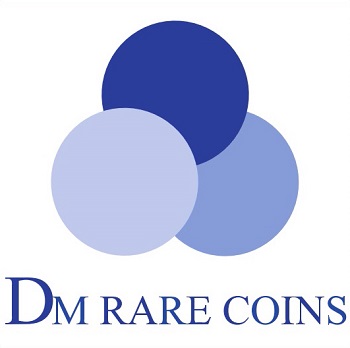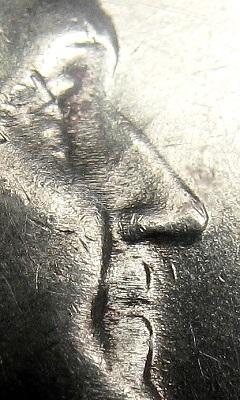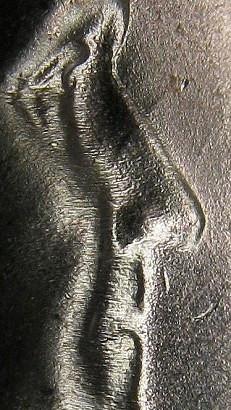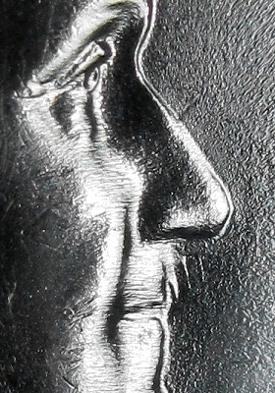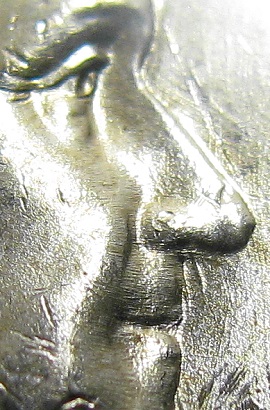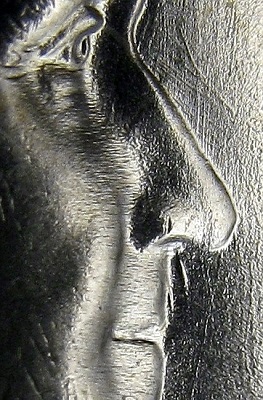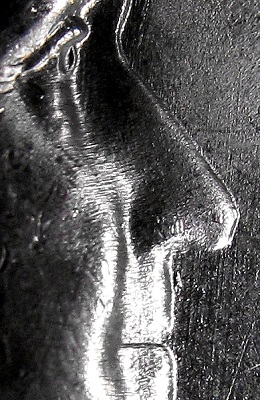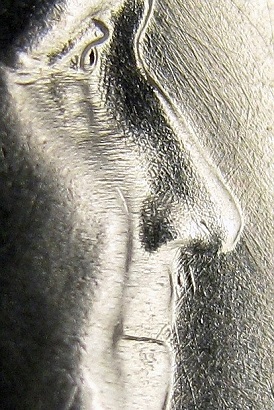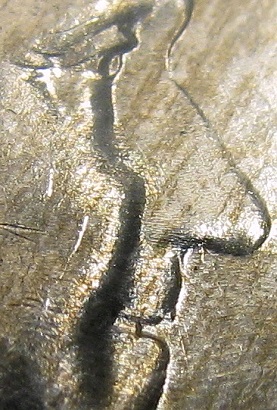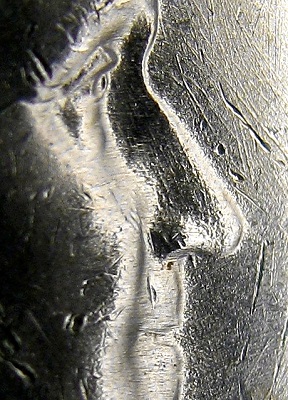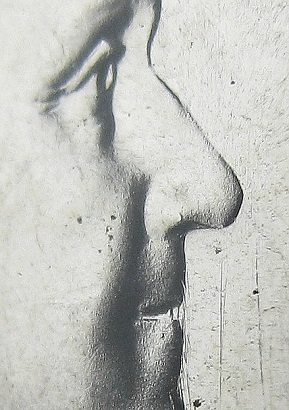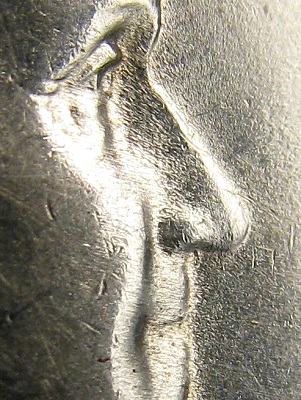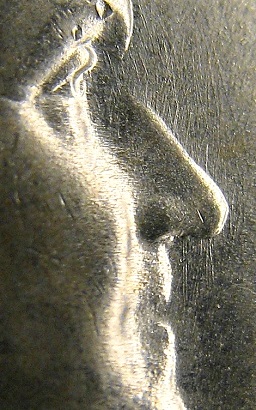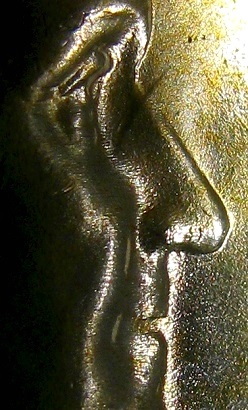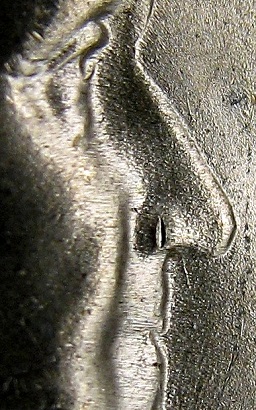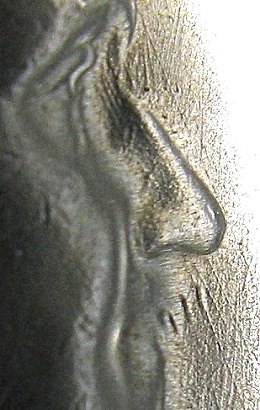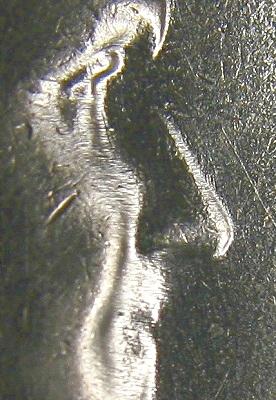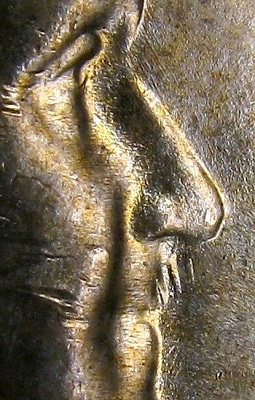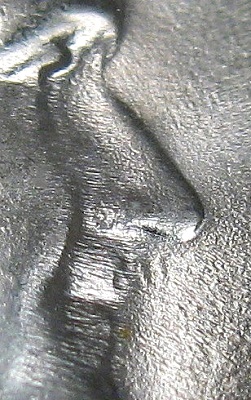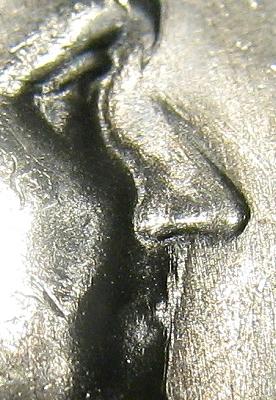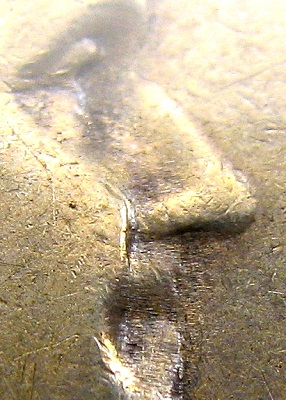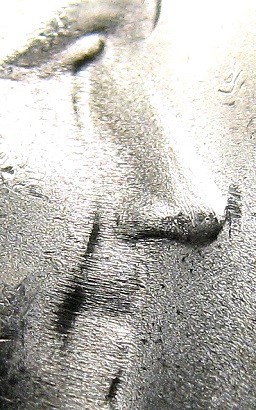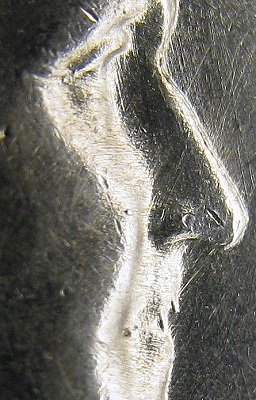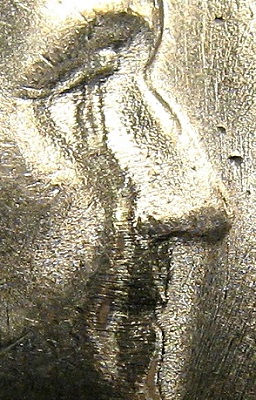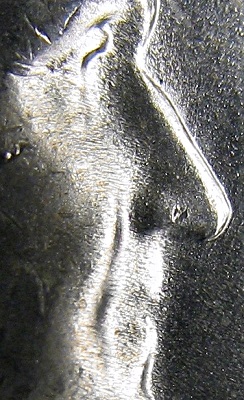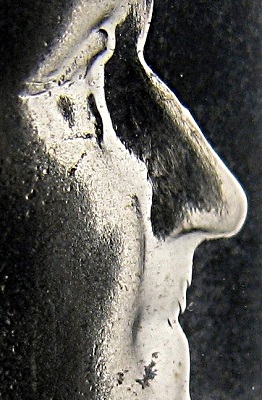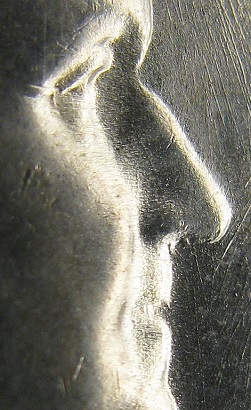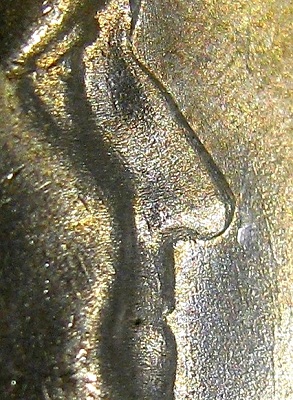Franklin Variety Index
Bugs Bunny Die Clashes 1948-1952
1948 FVI Bugs Bunny B-1
Two clash marks angling from or near upper lip, with strongest of the two floating in the field. The line closest to lip often weak. Crease through nose, letters behind head, bulge in field at neck has been freshly filed down. Bulge under eagle.
A scarce, early stage exists with shimmering, semi-PL surfaces and crisscrossing die lines from freshly polished dies.
1948 FVI Bugs Bunny B-1a
Heavily eroded, grainy dies have left just one line under the nose, with no trace of the line closest to lip. Most clash features remain visible but weakened by the granular frosting that has developed over both sides. Few die lines till visible.
1949 FVI Bugs Bunny A-2
Long, crisp, clash lines overlap the open mouth; two in front of lip and one on the tip. These lines rise up high from the fields and have a knife edge in the early stages. This is another very nice impression of the eagle's wing, similar to A-1. However, the position is higher and the other features are also different. The extra long spikes are connected under the nose by a horizontal line. Faint crease on center of nose. Collar clash on neck extends into field, forming a long, thin, curving line, running along the length of the neck to the chin. No letters behind head. Interesting check mark-shaped die lines in field in front of eyes. Most clashing on reverse has been concealed by die filing lines.
1949 FVI Bugs Bunny A-2a
The two strongest fangs are all that remain. The horizontal line under nose has faded, as has the spike on tip of lip. The collar clash has shortened. The differences between A-2 and A-2a are fairly minor, but the die progression is important in distinguishing this die pair from A-1.
1949 FVI Bugs Bunny B-1
One small tear drop-like clash floats next to lip. Crisp, fresh dies with fine, vertical die lines in fields.
1949 FVI Bugs Bunny B-1a
The dies have clashed again, creating three additional tear drop clashes surrounding the first. Extensive new die polishing lines are visible. Later stages show a die chip on lower bell lines, then a crack from chip to edge, and then a second crack through ME of AMERICA, running into bell hanger.
1949 FVI Bugs Bunny B-1b
Die erosion has now erased the two lightest clashes, leaving only two lines visible near the lip. The dies have become extremely grainy. Two reverse die breaks have become more pronounced, and the crack through ME has expanded into a tootsie roll-shaped die break. Coin must show both the die chip in the bell lines and the expanded break under ME to be classified as B-2b.
1949-D FVI Bugs Bunny C-1
Four strong clash spikes; one from inside mouth, one on tip of lip, one from the corner, and one from near middle of nose. Strong, multi-line collar clash and small goiter clash under chin. Faint cap on bell shoulder. Minimal clashing elsewhere. Obverse shows an interesting array of die scratches around and above the date. Typically a late die state with grainy surfaces.
1949-D FVI Bugs Bunny C-1a
Dies partly refinished and re-engraved features. One noticeable spike still shows inside open mouth, and lip now distorted to an awkward point. Very faint trace of the two clash lines under nose. Heavy, crisp crease, high on nose, almost in line with eye brow. This may be evidence of a new clash, or it may be a new die line. Eye ball now broken by polishing. Collar clash still very strong, and small goiter clash still visible. Both sides show a new pattern of die polishing, in addition to the old die scratches. Very slight cap on bell shoulder still visible. Damaged right side of bell, with a few sloppy, hand re-engraving lines. Nearby, a long die line connects eagle's wing to bell. The lowest bell line has been extensively hand re-engraved on both sides. A very intriguing stage of the variety!
1949-S FVI Bugs Bunny A-1
The upper lip is divided into three spikes: one inside the mouth; one distorting the tip of the lip; and the third, a long and sharp barb, bisecting the upper lip very nicely. A true A-position variety. Remnants of crease and spike on center of nose. Collar clash aggressively filed off, leaving a divot in the profile. Mint mark well above bell bolts and shows s split-serif RPM.Obverse and reverse dies have been completely and aggressively filed and polished, erasing most other traces of clashing and leaving Prooflike reflectivity. A rare early stage.
1949-S FVI Bugs Bunny D-1
A clash line drops from the center of nose, but is surrounded by heavy die filing lines. The extreme die polishing has resulted in fully Prooflike surfaces on both sides. Bulge under eagle's wing and light cap on bell shoulder.
This rare stage represent the first coins struck following the discover and polishing of the die.
1949-S FVI Bugs Bunny D-1a
The single clash under nose remains, and actually shows more clearly now that die wear has erased the filing lines.
Stage "a" begins when coin is no longer Prooflike. Thus, these will range from semi-PL to heavily frosted. Clash becomes indistinct in very late stages, and its desirability diminishes with it.
1950 FVI Bugs Bunny C-1
Two strong clash lines coming from nose, some clashing in open mouth. Strong collar and goiter clashing on neck and chin. Faint nose clash on right bell and small cap on right bell shoulder.
1950 FVI Bugs Bunny C-1a
The two clash lines from nose are polished down to short nubs, faint clash inside mouth. Nose polished away in front of eye. Strong collar and goiter clashing on neck and chin. Only faint nose clash on right bell and small cap on right bell shoulder.
1951 FVI Bugs Bunny A-1
Four extreme clashing lines create a nearly full wing impressed over Franklin's mouth and into field. The upper lip is boldly forked and the clash is oriented very low, with the first spike cutting well into the lower lip. Letters behind head. Nose polished away in front of eye. Horn-shaped goiter in field. Reverse heavily filed next to bell to remove most clashing.
1951 FVI Bugs Bunny A-1a
An extremely late die state that shows just a trace of the forked lip, and no more than a suggestion that clashing once existed in the field. A much diminished stage.
1951 FVI Bugs Bunny A-2
Extreme clashing, with three or four prominent clash lines starting right on top of the upper lip, in a much higher position than seen on FVI Bugs Bunny A-1.
1951 FVI Bugs Bunny A-2a
Only a shadow of the original Bugs Bunny clash remains. Due to heavy die erosion, it shows two or three floating lines in the field that no longer seem to touch the lip. Later die states than the one pictured will have greatly diminished visibility.
1951-S FVI Bugs Bunny A-2
Boldly forked upper lip with two distinct spikes.
The sample coin is a low circulated grade. This may prove to be the same die as 1951-S FVI Bugs Bunny A-1, but there are enough visual differences to suggest otherwise, at least until a higher grading example is found to prove one way or another.
1951-S FVI Bugs Bunny C-1
Two nice spikes angle down from under nose. Slight clashing inside open mouth. Collar clash. Reverse shows faint bulging under eagle and faint cap on bell shoulder in earlier stages.
1951-S FVI Bugs Bunny C-1a
The diminished late stage shows heavy die erosion that largely obscures the clashing, though a line is still visible near the lip. Less desirable than earlier stages.
1952 FVI Bugs Bunny A-1
Two heavy cylindrical spikes fork the mouth and upper lip. Heavy collar clash presses on curve of neck, goiter clash under chin. Heavy canvas pattern of die filing and polishing. Just a slight bulge under eagle. Re-engraved right bell wall. Usually found somewhat glossy due to the excessive polishing.
1952 FVI Bugs Bunny A-1a
Heavy die wear has begun to erase the Bugs Bunny, with only the outer spike on lip still visible. This is a diminished stage of the variety.
1952 FVI Bugs Bunny B-1
Faint flaring at the tip of the upper lip . Collar clash sits lower than on 1952 A-1. Light goiter clash under chin. Deep rectangular bulge under eagle appears in extra low position. Capped bell shoulder.
The most common 1952 Bugs Bunny. A weak variety, but considerable clashing elsewhere.
1952-D FVI Bugs Bunny C-1
Two cylindrical spikes protrude from nose, one near corner, one centered. Multiple remnants on tip of lip and inside open mouth. Earliest stage shows sharp spike on tip of upper lip. This is the strongest 1952-D variety. Pronounced goiter at base of neck and under chin. Crease through upper center of nose. Very heavy die scratch running above GOD WE. Strong nose clash under eagle with damage to right side of bell. Unusually crisp, shallowly punched mint mark, right of center, with its base well above the top of the bell bolts.
1952-D FVI Bugs Bunny C-2
Two moderate spikes protrude from nose, one near the corner, the other centered. These become easier to see in later stages because numerous surrounding die lines fade. Pointed upper lip and slight clashing in open mouth, in some stages. Slight collar clash. Heavy pattern of die polishing in fields around bust. Nose clash under eagle. Unusual die gouge running diagonally through clapper, on all seen. Normal D mint mark, punched well right of center, with base level with bolts.
1952-D FVI Bugs Bunny C-3
Small, sharp spikes show inside open mouth and on tip of lip. They fade with die progression. Just a nub filling the corner between lip and nose makes this a C position clash. Extreme collar and goiter clashing, starting at base of neck and running all the way around chin, is visible on all stages and is primary visual. Crease through highest point of nose lines up with eye brow. Long parallel polishing lines in fields. Patches of die scratches and re-engraving lines found on design elements from hand working. Lower right side of bell obviously re-engraved. Small, heavy, normal D mint mark, just left of center and level with bell bolts.
1952-D FVI Bugs Bunny D-1
Two strong spikes from nose, one merged with upper lip, the other left of center. Some distortion inside closed mouth, but not well-enough defined to call clashing. Faint collar clash and faint crease high on nose. A very nice variety. Only notable die lines are behind hair, cutting into back of Franklin's head. Faint nose clash on right bell, just above bell lines. Normal D mint mark, just left of center, with base well below level of bolts.
